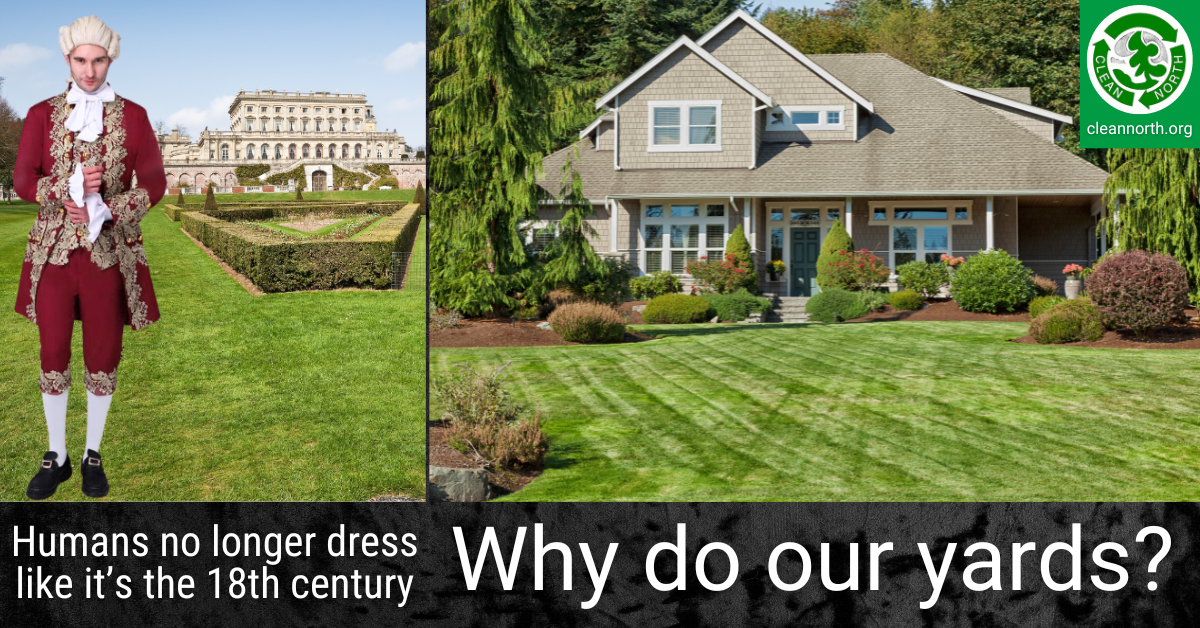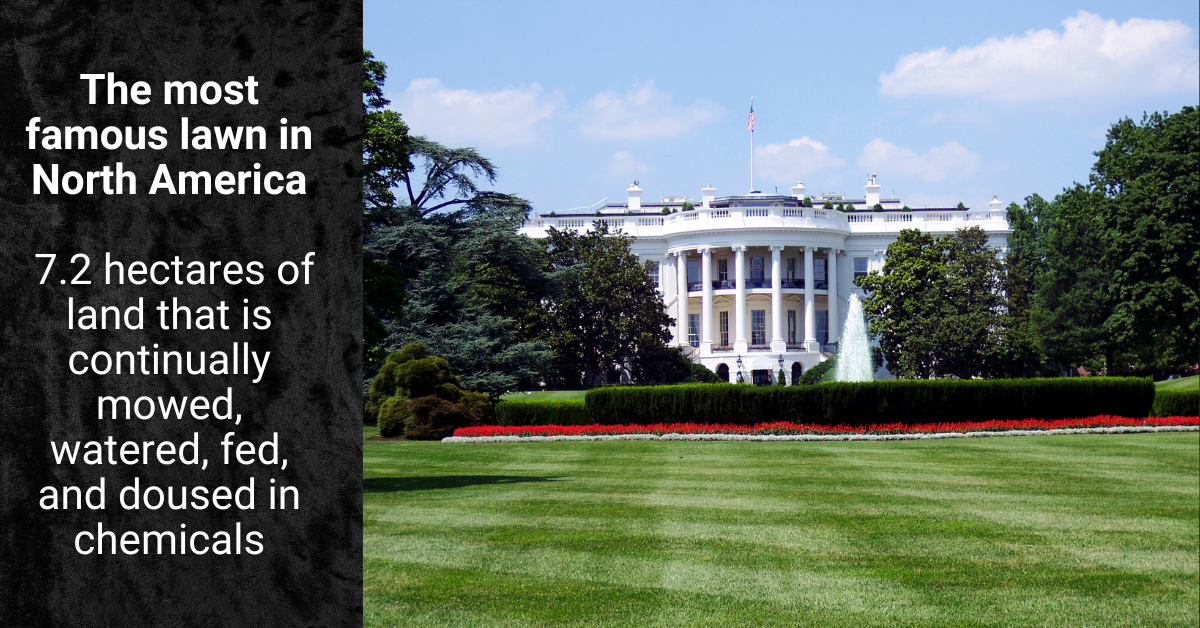
What’s the largest irrigated crop in North America? Would it shock you to learn that it’s our lawns? So in a time of climate change, with ever-increasing droughts and wildfires, our lawns—which produce no food and little ecological value—are getting more water than any other crop. More than corn. More than wheat. More than soybeans. Does this make sense to you?
Then add in all the chemicals poured on lawns to create that magic emerald green carpet: Fertilizers. Weedkillers. Insecticides. (And yes, we know that cosmetic use of the latter two is banned in Ontario. We also know many people ignore the ban.) These chemicals harm us, our pets, and nature (read more).
And to what end? So we can be stuck in a resource- and labour-intensive cycle of mow-water-apply chemicals-repeat for a space that most of us rarely use?
“A lawn is nature under totalitarian rule.” ~Michael Pollan
The elitist origin of lawns
The modern lawn originated in England in the 17th century, and surprise, surprise, it first showed up on the properties of wealthy landowners. Before lawnmowers were invented, only the rich could afford to hire all the people needed to maintain sweeping lawns.
Thus, lawns were (and still are) a signal of wealth and status—the bigger, greener, and more weed-free they are, the more status the property owner has. Which is messed up when you consider all the resources used and harm caused to the environment.

‘Mow’ lawn facts…
- Turfgrasses (including Kentucky bluegrass!) are native to Europe, not North America. They are not adapted to our conditions, which is why they tend to need a lot of watering and other care.
- Many of the weeds in our lawns are not native or are even invasive species. So simply letting our lawns grow out is not the best way to help nature.
- We’ve developed a standard of perfection for lawns that results in our spending a lot of money and time applying lawn chemicals, with risks for people, pets, and wildlife. And because cosmetic use of herbicides and insecticides is illegal in Ontario, we often don’t know when our neighbours have applied it. It’s done under the radar, with no warning signs posted. Thus kids, pets, and wildlife may romp across it before it’s safe to do so.
- The power tools we use to maintain lawns are highly polluting. For example, the pollution from cutting grass with a gas-powered mower for an hour is about the same as driving a car 100 miles!
Here in Canada, as of 2019, the percent of households using pesticides*
was 20%, a slight increase. This is despite widespread legal restrictions.
The percent of households using chemical fertilizers went down
from 1994 to 2011, but it increased after 2011 to reach 28% in 2019.
Source
*Pesticide is a catchall term that includes any substance used to kill pests—weedkillers, insecticides, fungicides, rodenticides, etc.
Alternatives to a manicured lawn
- Keep the lawn, reduce the maintenance. For example, mow less often; consider getting an electric or manual mower to reduce emissions; reduce/eliminate use of chemical weedkillers, insecticides, and fertilizer; stop watering; and let your lawn go dormant in mid-summer. Fun fact: Mowing your lawn less often helps insect biodiversity, which in turn helps birds and other wildlife (read related research article).
- Replace part of your lawn with low-maintenance native ground covers like wild strawberry or native sedges (other options).
- Replace part of your lawn with a native plant garden designed to support bees, butterflies, birds, and other wildlife and reduce use of water/chemicals (check out recommendations in the Sault/Algoma Grow Me Instead Guide).
Some say we should all kill all of our lawn, but let’s be realistic. Replacing an entire lawn can be a lot of work, and if you don’t do it in an aesthetically pleasing way, your neighbours may complain. Plus many people want to have at least some lawn so their kids/pets have room to romp.
How to kill your lawn
Start with shaving and edging
Cut the area of lawn you wish to kill as close to the ground as possible to stress it. Then: “When creating a new garden in existing sod, I first use a half moon edger to remove a V-shaped slice of sod around the edge of the new garden,” says Halton Region Master Gardener Claudette Sims. “This edging helps prevent the grass from growing into the new bed.”
Next, lose the lawn (two options)
1. Digging it out
This method gets rid of grass fast, but it’s hard work and practical for only a small area. Down sides include losing at least some soil that’s clinging to the sod and exposing weed seeds. After removing the sod, we recommend you apply some compost or mulch to enhance the soil. Then you can add your native plants.
What can you do with the dug-up sod?
- Never dump it in a natural area as it may contain roots or seeds of invasive species.
- Use it to plug bare patches in your lawn.
- Put it in black trash bags and place them in the hot sun to “cook” for a few weeks to kill the grass and hopefully most weed seeds (fast but requires a bit of space).
- Put it in leaf bags in a corner of your yard to compost for a year.
- Put in a pile and cover with a tarp—clear plastic works well in sun and will “cook” sod quickly; black plastic is slower
- Let it dry out thoroughly to kill the grass/weeds and reduce its weight/volume, then compost it or spread it back over your lawn as a top dressing.
- Put it in a large tub or trash can filled with water to drown/rot it (smell can be an issue here, along with mosquito production), then drain, dry, and compost or spread on your lawn as a top dressing
2. Smothering it
This method takes a lot longer to kill your lawn (1-2 months depending on conditions), but it’s less labour intensive and more practical for larger areas—and there’s no dug-up sod to contend with. Options:
- Heavy mulch: Spread wood chips 8-12″ deep over the area of lawn you wish to kill. Tip: Some tree-trimming companies will drop off wood chips on request. Once the grass is dead/decomposed enough to dig through and before planting, reduce the mulch layer to 3-4″. Deeper mulch is not healthy for trees, other plants, and the soil.
- Cardboard/paper: Lay down sheets of corrugated cardboard (remove plastic and staples), newspaper, paper yard waste or grocery bags, or commercial paper mulch. Overlap edges by at least a foot. If you don’t like the look of sheets of cardboard/paper, you can top them with mulch or compost. Mulch/compost will also help keep the cardboard/paper in place—or you can use rocks or bricks. FYI: Some people are concerned about chemicals in cardboard—avoid using cardboard that has a shiny coating as that’s higher risk. Check out this excellent post that weighs the pros/cons of using cardboard in gardens and offers tips.
Because of provincial restrictions on use of herbicides, we won’t address using these to kill your lawn. We also caution against using “natural” herbicide concoctions containing vinegar, salt, dish soap, etc. (Read more on the Halton Region Master Gardeners website.)
“But what if I want to plant right away?”
If you are using the paper/cardboard method, you can plant right away. Put soil on top of the cardboard and plant smaller plants into the soil. If you are committed to planting larger plants with deep roots right away, you can cut planting holes, insert the plants, and keep an eye out for grass/weeds growing up through the holes.
Planting immediately with the heavy mulch method is tricky because plants may struggle with a deep layer of mulch around them.
Final caveats about establishing native plant gardens
- Over time, native plants should need less tending. But in the first year or two, they will likely need regular watering and weeding. If you don’t water and weed, the native plants you are trying to foster may struggle, and neighbours may complain if your garden looks “messy.” Applying 2-4″ of mulch around native plants can help reduce weeds.
- When setting up new garden beds especially in the front yard, it’s wise to check and follow your municipality’s gardening bylaws, for example, around establishing a garden in the boulevard.
To learn more about recommended native plants for Sault Ste. Marie/Algoma, check out our Grow Me Instead Guide.
Questions?
Email us at info@cleannorth.org.




